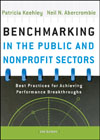
Based on new research, this second edition of the best-selling book provides an updated solution-driven methodology for benchmarking in both the public andnonprofit sectors. Unique in its focus solely on benchmarking, it takes a how-to step-by-step approach to two benchmarking techniques, provides new tools and details for other entities to replicate those techniques. The book includesupdated cases and expands its readership to include the nonprofit sector through its use of examples from nonprofits as well as the international community. INDICE: Figures, Tables, Exhibits, and Worksheets. Acknowledgments. The Authors. Introduction. PART ONE: WELCOME TO BENCHMARKING. 1. The Foundations of Benchmarking. Historical Context. Benchmarking in the Twenty-First Century. Summary. 2. Benchmarking and Performance Measures. Purpose of Performance Measures. IPOLO Model of Performance Measures. Performance Measures and Government. Performance Measures and Management. Importance of Measures, Comparisons, and Benchmarking. Selecting Measures for Benchmarking. Measurement Challenges in the Public and Nonprofit Sectors. Summary. PART TWO: BENCHMARKING METHODS. 3. Preparing for Benchmarking. Determine Readiness for Benchmarking. Select a Benchmarking Method. Major Benchmarking Pitfalls. Summary. 4. The Traditional Benchmarking Method. Other Views of the Benchmarking Methods. Eleven-Step Traditional Benchmarking Method. Examples of Traditional Benchmarking. Warnings About Traditional Benchmarking. Summary. 5. The Solution-Driven Benchmarking Method.Snapshot of the Solution-Driven Method. Steps in the Solution-Driven Method. Examples of Solution-Driven Benchmarking. Common Sense or Methodology?. Warnings About the Solution-Driven Method. Summary. PART THREE: BENCHMARKING IN SECTORS. 6. Benchmarking in State and Local Government. Historical Overview. Benchmarking and State Governments. Why State and Local Governments Pursue Benchmarking. Who Should Participate in a Benchmarking Project? Is the Public Sector Better off Due to Benchmarking? Criminal Intake in Salt Lake County, Utah: A Solution-Driven Approach in the Public Sector. Summary. 7. Benchmarking in Nonprofits. What Is a Nonprofit? Pressure to Benchmark. Nonprofit Leadership and Solution-Driven Benchmarking. Examples of Solution-Driven Benchmarking in Nonprofits. eNonprofit Benchmarks Study. Selecting Potential Benchmarking Partners. Thinking Ahead. Summary. 8. Benchmarking in the International Community. General Characteristics of International Benchmarking. Examples of International Benchmarking. Lessons Learned. Summary. PART FOUR: BENCHMARKING AND ACCOUNTABILITY. 9. Benchmarking for Improving Accountability. What Is Accountability? Increased Attention to Accountability. How Benchmarking Contributes to Accountability. Summary. 10. Benchmarking and Performing an Audit. Why Use Benchmarking in Audits? Basic Benchmarking Skills for Auditors. Using Traditional Benchmarking in Audits. Using Solution-Driven Benchmarking in Audits. An Example from the DOI. Warnings About the Solution-Driven Method. Solution-Driven Benchmarkingand the Audit Plan. Summary. 11. Conclusion. Sustaining the Momentum for Benchmarking: Creating a Learning Organization. Conducting Needed Research. Next Steps. Resources. Glossary. References. Index.
- ISBN: 978-0-7879-9831-8
- Editorial: Jossey Bass
- Encuadernacion: Cartoné
- Páginas: 256
- Fecha Publicación: 28/05/2008
- Nº Volúmenes: 1
- Idioma: Inglés
